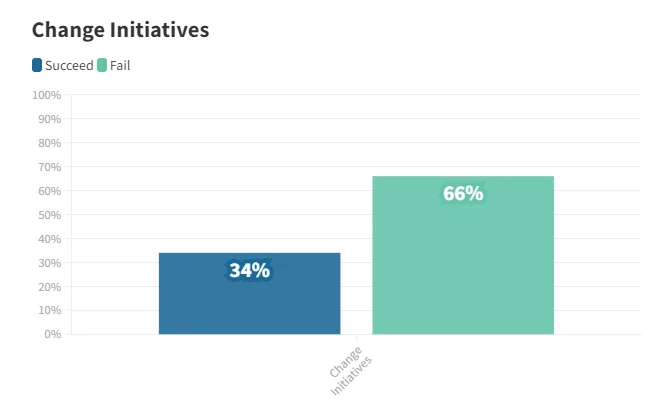
With the market’s rapid growth, every business is exploring various methods to win in a never-ending battle with other organizations, and as a response, it is undergoing some change. By focusing on the human factor, change management aims to support all employees as they go through change so that the organization can achieve its best outcomes.
WalkMe has provided some insightful statistics on change management, the causes of unsuccessful transitions, and much more.
Key Takeaways
- 47% of organizations that integrate change management are more likely to meet their objectives than the other 30% that did not incorporate it.
- Only 34% of change initiatives succeed.
- 79.7% of people need to adapt their business every two to five years.
- One in three CEOs failed to achieve the desired outcome from past transformation initiatives.
- Two-thirds of workers experience burnout crisis, which further causes transformation failure.
- Workplace stress accounts for 8% of national health care spending.
- The digital transformation market is projected to reach $1,009.8 billion by 2025.
Change Management
Change management helps manage the transformation of an organization’s goals, processes, and technologies, by focusing primarily on preparing, supporting, and helping employees undergo change as they’re the organization’s core.
As a result, high-quality change management approaches increase an organization’s likelihood of achieving the intended effect with its planned strategy. Additionally, in order to help your employees undergo change and support them throughout the process, you would have to incorporate change management into your planned strategy.
In a world this complex, change is necessary more often than not. However, about 66% of change initiatives fail, and only 34% succeed. Additionally, 96% of firms are undergoing some transformation right now, and within the past 24 months, half have finished at least one transformation journey.

Major Causes for Change
What causes the need for change in business organizations?
Market competition
A principal analyst Bryan Solis reveals in his research that at least 51% of survey applications chose market competition and growth opportunities as a cause for change.
Competitive pressure
41% of survey applicants selected competitive pressure as the main reason for change. In a market where new business startups are constantly emerging, 79.7% of people need to adapt their enterprises every two to five years to survive.
Evolution of technology
The main driver of change over the years has been advancements in technology. People do not, however, keep up with the rapid advances in technology. Because change affects a team’s performance and, by extension, the entire business, organizations need to keep their employees informed of new developments and mentor them through the transition.
Crisis response
Every organization ought to be ready for these crisis situations. A fresh strategy that will stop the crisis from doing more harm to the organization should be put in place right away as the organization’s response. While the leadership component focuses on the plan, another area of attention should be on the employee, understanding how they will adjust to that change and by consistently giving them an impression that their opinions are valued.
HR and Change Management
HR should help organizations run the change management process as smoothly as possible by providing a new strategy in place. A transformation of a company might mean a new software program, a new training program, reorganizing departments, and switching to remote working. HR with change management is interested more on the people’s side and the culture of the organization.
In order for a strategy to be successful, companies need to analyze what will change and most importantly who will be impacted. Organizations need to know what employees are dealing with, as some do not want any form of change in their lives, especially those in their workplaces. Further, organizations should develop the plan, execute it, and measure their results.
If Organizations want Employees to Adapt to the change, they will need to:
- Establish a two way communication effort
- Make them feel valuable by asking for their opinion
- Be with them through every step of resistance
- Establish a new strategy that benefits them more
Four Factors That Impact Change for the Better
Duration
Time is of the essence especially in crisis situations where we need to respond. Harvard Business Review demonstrates that a long project that is reviewed frequently has a higher success rate than a small project that isn’t reviewed frequently.
Integrity
Companies should choose a team leader which will guide the other employees towards success. Most importantly, leaders should clarify the employee’s roles and responsibilities in terms of the strategy in place.
Commitment
Commitment is a mutual part between the company and employee. As companies expect employees to commit to the strategy, the company should as well commit to employees. It is not enough for the company to commit to managers as what may be seen as a good strategy will not be the same for employees. So, encourage building staff support in your organization..
Effort
Companies often overlook the fact that their staff members are already occupied with daily responsibilities while planning for transformation. Therefore, implementing a strategy that only results in a 30–40% increase in employee workload would simply cause resistance and failure inside the firm. So, make sure to estimate the necessary adjustments and how much extra work the employees will have to complete on top of their regular tasks, and try not to go over 10% of each employee’s workload.
What Causes Transformations to Fail?
One in three CEOs admit that they have failed to achieve the desired outcome from past transformation initiatives when it comes to bringing new strategies within the organizations. So, what causes the transformations to fail?
Underestimation of Operating Model Changes
The most common barrier to transformation failures is that 37% of executives tend to underestimate the importance of operating model changes within the organization and their impact through the transformation phase.
Employee Resistance
The most crucial aspect of organizational changes is the cooperation of the workforce. If they don’t support the change, the transformation won’t succeed. As a result, employee resistance in regard to change and lack of management support causes at least 70% of change initiatives to fail. However, there are some cases when 30% of employees commit to the change and continue with the transformation.
Lack of Communication by the Upper Management
If there is a lack of communication, clarity, and unmanageable workload by the manager, that will lead to employee burnout crisis—a state of physical/emotional exhaustion. In a survey conducted by Gallup with over 7,500 full-time employees, it was found that two-thirds of workers feel workplace burnout.
As a result, employee burnout causes a loss of productivity, engagement, motivation, impatience, and increased stress, which can conflict with the organization’s goals and new strategies. Workplace stress also impacts employee health, accounting for 8% of national health care spending ($125 to $190 billion) and causing 120,000 deaths yearly.
Digital Change Transformation
What sets digital change transformation apart from change management is the drive to integrate digital technology into businesses—a transformation within the firm that affects technology, culture, work, and much more.
For more than 20 years, various businesses have been gradually converting themselves with digital technology in order to adapt to the constantly shifting market. Then COVID-19 occurred, which altered the process for nearly all businesses.
According to a survey conducted by Twilio, at least 97% of decision-makers believe that the pandemic sped up their company’s digital transformation process. As a result of the pandemic, 95% of all companies are looking for new methods to interact with their customers.

The digital transformation market is more focused on cloud computing, artificial intelligence (AI), big data and analytics, mobility/social media, cyber security, and so far. Further, the global market for digital technology has been expanding quickly, reaching $421.8 billion in 2020 and projected to reach $1,692.4 billion by 2030.
Leaders are now using AI to assist employees with the aim of bringing more success within their organization. According to a 2020 report, 58% use AI to improve consistency and quality, 26% to improve productivity, and 16% to improve insights.
What to Expect in the Future?
AI is being implemented in today’s world in big companies such as Google, Facebook, and Amazon; however, it is just the beginning, as employees will be affected by automation, advancement in digital skills, and so on.
By 2030 it is predicted that human labor will no longer be necessary in specific industries as a result of AI and machine learning. Some of the positions expected to be automated are:
- Warehouse and manufacturing jobs
- Customer service
- Production line evolution
- Banking services and retail checkout
The digital transformation will only increase as new software platforms are released daily, so to survive, companies will have to adapt and integrate new tools, as well as install and deploy them.
Even though it was COVID-19 that increased the rate of digital transformation through modern technology within the company, that will continue in the future as 92% of decision-makers believe that their organization is very likely to expand digital communication channels.
Established change frameworks, resistance management, and risk analysis processes will not change; however, technology will impact the future of change management as it is advanced every day, with more than 5,382 million users active in 2022.
What Can You Do for Transformations to Succeed?
- Define the outcome of change
- Build a solid and committed team
- Support and encourage your employees
- Create a road map
- Monitor and manage risk
WalkMe Team
WalkMe spearheaded the Digital Adoption Platform (DAP) for associations to use the maximum capacity of their advanced resources. Utilizing man-made consciousness, AI, and context-oriented direction, WalkMe adds a powerful UI layer to raise the computerized proficiency, everything being equal.


